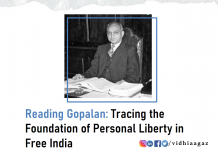Introduction | The Constitution (Fifth Amendment) Act
The Constitution (Fifth Amendment) Act, enacted in 1955, amended Article 3 of the Indian Constitution which enables Parliament to effect, by law, reorganisation inter se of the states constituting the Indian Union. The Parliament is empowered to enact a law to reorganise the existing states by establishing new states out of the territories of the existing states, by uniting two or more states or parts of states, by uniting any territory to a part of any state, by altering their boundaries; or by separating territory from, increasing or diminishing the area of, or by changing the name of, a state.[1]
Original Amendment Act can be seen HERE
History behind the Constitution (Fifth Amendment) Act, 1955
The original Article 3 was so drafted because of three main reasons:
- When it was drafted, the Princely States had not been fully integrated,
- There was also the possibility of reorganisation of states on linguistic basis; and
- Constituent Assembly had foreseen that such reorganisation could not be postponed for long.
Therefore, accordingly, Article 3 was incorporated in the Constitution providing for an easy and simple method for reorganisation of the states at any time.
Difficulty in Article 3
A difficulty arose when it was found that the original Article 3 did not lay down a time-limit within which the states concerned were to express their views. The absence of any such limit could cause delay or even bring the parliamentary legislation, for the said purpose, to a standstill. The government of India was anxious to expedite the reorganisation of the states on a linguistic basis which was however hampered by the Parliament merely by non-expression of its views for any length of time.
Resolution for the difficulty
The Amending Act, therefore, made it possible for the President to set a time-limit through which the Parliament could proceed with the matter without waiting for the views of the state concerned. This Amendment made the proceedings regarding reorganisation of states efficient and this propelled the states to check on the issues related to them responsibly. After the amendment, the procedure was changed and the exercise of this power by the Parliament was subject to the following conditions:
(1) A Bill for any such purpose cannot be introduced in the Parliament except on the recommendation of the President.
(2) If the Bill affects the area, name or boundaries of a State, then before recommending its consideration to Parliament, the President has to refer the same to the State Legislature concerned for expressing its views on it within such time as he may fix.
Article 3: Post Amendment
Andhra Pradesh was the first state to be reorganized after independence wherein it was separated from the erstwhile Madras Province. The formation of Andhra Pradesh was one such example of the reorganization which became a reason for the amendment to the said article.
Article 3 gave Parliament the authority to pass the bill of reorganisation. But to pass it, the bill first had to be passed by the State Legislature. The purpose of the provision was to give an opportunity to the concerned State Legislature to express its views on the proposals contained in the bill. Parliament was however in no way bound by these views. All that is contemplated is that the Parliament should have before it the views of the State Legislature affected by the proposals contained in the bill, but the Parliament is free to deal with the matter in any manner it thinks fit and may accept or reject what the State Legislature says.
Confusion for meaning of words
After the amendment, a lot of confusion surfaced regarding the meaning of the terms “express view of the State Legislature” resulting in a blatant violation of Article 3 and in a drastic increase in the number of cases. The confusion was finally put to rest by the Apex Court in Babulal Parate v. The State Of Bombay [2], when the State Reorganization Bill was introduced in the Lok Sabha. Some of its clauses, precisely Clause 8, 9 and 10, contained a proposal for the formation of three separate units, namely, (1) Union Territory of Bombay; (2) State of Maharashtra including Marathwada and Vidharbha and (3) State of Gujarat including Saurashtra and Cutch.
The Bill was introduced in the Lok Sabha on the recommendation of the President as required by the proviso to Article 3 of the Constitution. This was then referred to the Joint Select Committee of both the houses which made its report dated July 16, 1956. In furtherance of the Report, some parts of the Bill were amended by the Parliament. On being passed by both the houses, it received the President’s assent and came to be known as the State Reorganisation Act, 1956, hereinafter called the Act. Instead of three separate units, a composite state of Bombay was constituted under Section 8(1) of the Act.
Facts of the case
In this case, the Appellant on September 12, 1956 filed a writ petition under Article 226 of the Indian Constitution in the High Court of Bombay challenging the formation of the composite state of Bombay. It was the submission of the Appellant that the formation contravened Article 3 of the Constitution in as much as the legislature of Bombay had no opportunity of expressing its views on such formation. The Appellant accordingly prayed that Section 4 and other allied sections of the Act are void and thus they should not be enforced. The Writ Petition was dismissed by the Bombay High Court on the ground that there is no violation of Article 3 of the Constitution. Thus, the Appellant had filed an appeal under Article 132(1) of the Indian Constitution by obtaining the competent certificate.
Issue
What is the scope and effect of Article 3 of the Indian Constitution and particularly that of the proviso thereto as it stands after the Constitution (Fifth Amendment) Act, 1955?
Judgment by Justice SK Das:
It is clear that the Article gives power to the Parliament to make laws in respect of any of the five matters as mentioned in clause (a) to (e). The substance part of the article is followed by the proviso which lays down certain conditions for the exercise of such power. The conditions laid down by the proviso are:
- No bill shall be introduced except by the recommendation of the President.
- Where the proposal contained in the bill affects the boundaries, area or name of the state, it has to be referred by the President to the Legislature of that State for expressing its views.
But there is nothing which says that the Parliament must accept or act upon the views as expressed by the State Legislature. Thus, the essential element of the second proviso is that the President must refer the proposal to the State Legislature. When a proposal contained in the Bill is modified subsequently by an amendment by the Parliament, the proviso does not say that a fresh bill must be introduced in the State Legislature.
Hence, there is no violation of Article 3 of the Constitution and the Act or any of its provisions are not invalid on that ground.
Conclusion
To conclude it all, we can say that the fifth constitutional amendment came to be a help and has played an effective and efficient role in reorganising the states as per the need. Henceforth, the amendment which brought in the clauses relating to time limit helped in persuading the state governments as well as the Parliament to seek their attention in the matters related to state reorganisation.
[1] M P JAIN, Indian Constitutional Law 8 (Justice Jasti Chelameswar, Justice Dama Seshadri Naidu, 2018)
[2] 1961 AIR 884
Want to work as a Research Intern with Centre For Constitutional Research and Development? VISIT HERE for detials.







